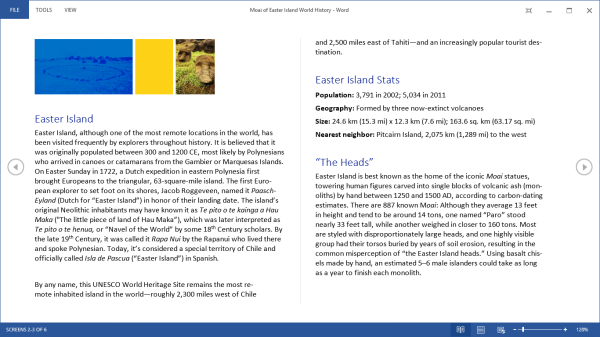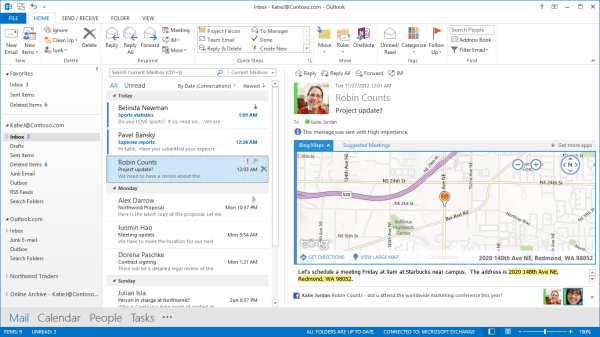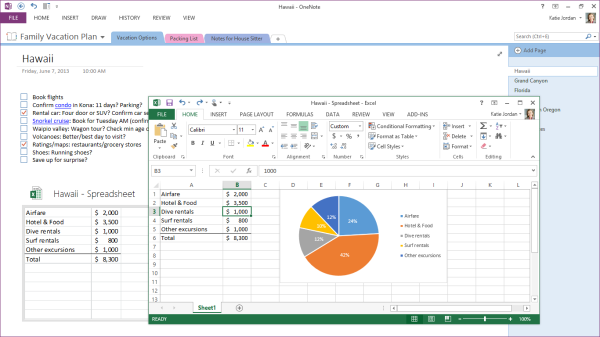Three Months with Microsoft's Office 365
by Vivek Gowri on January 31, 2013 11:59 PM EST- Posted in
- Microsoft
- Cloud Computing
- Office 2013
- SkyDrive
Word 2013 has a couple of nice features worth calling out. One is a viewing mode designed specifically for reading, which is pretty similar in theory to Reader mode in Safari, with text reflowing in columns to fit the display and all navigation and editing tools being hidden to present the document in a consumption-centric manner. The other is much better handling of PDFs - Word 2013 can now open PDFs and treat most content (text, tablets, formatting) exactly the same as standard Word docs. If you’ve ever had to deal with the nightmare of copying content from PDFs to Word, this is wonderful news. Unfortunately, now I’m done with college; it’s unfortunate that Microsoft didn’t decide to implement this in Word 2007 when it would have been legitimately useful to me. (Sidenote: perhaps this is a sign that I’m getting old, but I’ve had a number of moments in the first month of this year when I see new tech products and think to myself “Damn, I would have killed for that 5 years ago when I was an undergrad.”)
PowerPoint comes with significantly better audio and video media support, the ability to add pictures from online directly to the presentation instead of having to save and insert them, a new presenter view when you have a second screen (which is done automatically), more (and better) themes, some cool new transitions (in a category called “Exciting”), and better sharing and editing tools.
Excel’s improvements are primarily related to new charting options, but also a couple of new data tools. The new chart object styles are awesome, and the customizability of the data point styles and transparencies is much easier than it used to be. Other than new content and the visual refresh, the way you interact with the software hasn’t fundamentally changed much with the added features, which is why I’m kind of glossing over Excel and PowerPoint. They’re evolutionary improvements that don’t radically alter the user experience.
Outlook has been redesigned to look like a much more powerful version of the Windows 8 Mail application, with a colour scheme change from gold to blue. Inline replies are now the default, there are plenty of animations, and social networking integration is being touted as one of the more important new features. Clearly, this is not my father’s Outlook we’re talking about. It takes some of the better features from current mobile mail applications and integrates them into what was already the gold standard in desktop mail programs. There are new flyover boxes (called Peeks) to quickly show you schedule, calendar, or contact details without switching windows. The contact manager also does a better job of consolidating multiple contact details into a single card to reduce duplicates. Faster search, better filtering, and new views and in-line attachment and Bing map previews make the 2013 edition the sleekest and easiest version of Outlook yet. After using Outlook for a few days, going back to the Mail app is just a painful and torturous exercise.
With Office 2013, OneNote is making the jump from interesting and useful Office application to really being a vital component of the Office suite. With the rise of tablet computing and the touch-centric nature of Windows 8, this is understandable, particularly since most of the Intel-based tablets are coming with Wacom, N-Trig, or other active (pen-input) digitizers and even the Windows RT slates work well when paired with capacitive styli. That most Windows RT slates don’t come with capacitive pens out of the box is a failing of the device manufacturers, since the platform really lends itself to pen input.
OneNote 2013 features a lot of cross platform integration, with easily embedded objects and Office files (which automatically update when changed). So, if I was to put an Excel grocery list file into OneNote, any changes I made to it in Excel would be reflected in OneNote as well. Outlook meeting integration gives OneNote much more scope in the business realm than it previously had, particularly when combined with the improved search and linked audio features. Better inking, photo snipping, auto-save, and a full-page reading view just improve what OneNote was already great for.














113 Comments
View All Comments
colonelpepper - Friday, February 1, 2013 - link
this "article" is so obviously an advertisement... what an embarassment for anandtech.shame on you guys
..and on all the microsoft shills polluting this comment section.
what a friggin embarrassmet Anandtech. UNBELIEVABLE
ggathagan - Saturday, February 2, 2013 - link
As opposed to everything you've written.By your standard, you are a LibreOffice 'shill'.
As others have stated, the fact that Vivek happens to like the features of Office 2013 doesn't make him a shill, any more than your opinions make you a LibreOffice shill.
You may not have noticed, but there's no one with a gun to your head demanding that you use any MS product.
Feel free to live your entire life without a single MS product in your home.
That's the beauty of choice
versesuvius - Saturday, February 2, 2013 - link
Why pay all that money, when you can keep all that money. Open office is not as pretty, depending on one's moods and tastes of course, but it is ten times more reliable and in the long run more productive than any MS Office n-1.mechBgon - Saturday, February 2, 2013 - link
...exploitable, maybe. CERT's security shootout, have a look at the third chart:https://www.cert.org/blogs/certcc/2011/04/office_s...
Quality code, for a premium price. Choose your preference, I guess.
That said, I would probably get Office 2010 over Office 2013 at this point, since Office 2013 licenses can't be transferred to one's next PC. That's right, it's like an OEM Windows license, irrevocably licensed to the first PC you activate it on. And if you want to use it on your desktop and your laptop/tablet, Office 2013 requires you to buy a second license, whereas Office 2010 doesn't.
It appears to me that Microsoft is purposely poisoning Office 2013 with these licensing shens to get more people onto the subscription model.
versesuvius - Sunday, February 3, 2013 - link
I will not argue with that test, but my own experience is somewhat different. Apache Open office is in 3.4 version now and keeps getting better. In Europe, many governments and city authorities have adopted Open Office since its early versions (before Oracle and Apache), and that shows that the crash problems and productivity then were much more in favor of Open Office and with the latest improvements the situation has not changed much. Anyway for small business and individuals,if not with enterprises, Open Office makes a compelling case. After all 30,000,000 downloads for Apache Open Office alone is bound to make it a more viable platform every day. And again, it is free.mechBgon - Sunday, February 3, 2013 - link
You mean, the _up-front cost_ is free. How about the TCO? Microsoft has some compelling advantages there. Installation, security, updating, auditing, and configuration enforcement are all centrally manageable with Group Policy, WSUS, and MBSA, among other tools.It certainly beats hand-installing and hand-configuring a thousand workstations, wondering if the employees have altered the security configuration, wondering if they're up-to-date, and knowing that you had to allow Admin rights to update the software. Over the course of a 3-5 year lifecycle, which one's really cheaper? And how much does a security breach cost?
Then there's Open Office's deplorable inclusion of a Java Runtime Environment by default. If they were deliberately attempting to create a security liability, that's a great opening move.
versesuvius - Sunday, February 3, 2013 - link
Very few open source software updates like paid software. The reason for that is simply the fact that updating automatically requires an online server or actually many servers, which costs money. The free software only gives you a notification and the update is usually a download and an install into the same directory. But that does not mean that updating many installation has to be done manually. It can be done automatically through scripts or other methods. As I said governments in Europe have adopted Open Office since many years ago and they are very likely to have security as a high priority on their list. Anyway, all that you mention can be done through either OS services, with Linux being very good at it, or through scripts which any serious enterprise easily has the resources available for and in place already. An interesting point is that contrary to what you say, when it comes to thousands of installations the first time installation make the cost of Open Office almost the same as MS Office. (I remember in a European city, Microsoft's bid was lower than Open Office's, but the city went ahead with Open Office anyways). After that it is almost free with Open Office and permanently very costly with MS Office. I remember Microsoft at a time was offering the entire office suite for 3 dollars in China. It was done to combat piracy, but the end result is the same. It is the long run profits that Microsoft makes that is important to the company, not the initial payment.HisDivineOrder - Saturday, February 2, 2013 - link
...for a lot of users. I think you really covered that. You'd think they'd want to get everyone on the MS teet, suckling that Office goodness in a subscription they'd get for years and years to come. Just like you said, getting us to pay for more and more devices to have access.Instead, they're like confused about what they want to do. On the one hand, they want to charge the same as they always do for the single license, no subscription. And on the other, they want TONS of money from subscriptions, charging an insane amount for a year's worth of use of something. If they'd shave $10 off per copy that I wouldn't use on devices, let me decide how many devices i need to have access to the subscription, then this would be a great deal for me.
Otherwise, I don't think they get who their competition really is. Sure, they're competing with Google Docs, LibreOffice, OpenOffice, etc. But that's not the real competition they should be afraid of.
They should be afraid of everyone who has Office 2010/2007 who is looking at this and shrugging. Most of what 2013 offers in Skydrive functionality that ordinary users would appreciate can be duplicated by changing your FREE Skydrive account to look at your documents folder. And for anyone who had Skydrive before it was Skydrive, they have not 7 GB, but 25 GB already. I'd imagine quite a few of THOSE users already have Office 2010.
So... by pricing this in the stratosphere, they've killed any and all impulse buying of this product.
As far as I can tell from this "review," the only other real reason to get this is if you have a Touch device. How many x86 computers out there based on touch will be used via touch enough to make an Office built around touch worthwhile? How big is that audience?
flensr - Sunday, February 3, 2013 - link
No subscription for me, no way. I got office 2007 student edition back in 2007, for under $100 if I recall correctly. I'm still using it, 5 years later and have no reason to upgrade. I know how to use it, it's compatible with everything I need to do.A subscription would be a total ripoff for me and my family. I'm just not going to do it.
benedict - Sunday, February 3, 2013 - link
So Vivek graduated and got a job at Microsoft. Grats!